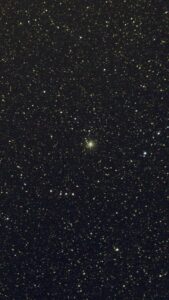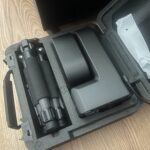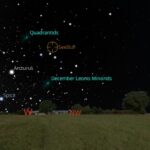
Sandy and I were on vacation on Ocracoke Island in North Carolina last week. I brought along the SeeStar S50 and was excited to get some views from the nice, very dark, Ocracoke sky. My plan was to EAA observe the remaining 7 Messier objects to complete my EAA Messier Log. Only had one really nice clear night while we were on Ocracoke Island, but that was enough. I had some great views and observed the last 7 Messier objects need to complete my EAA Messier Log and added 8 deep sky objects to the SeeStar Messier Log.
I sat up the SeeStar on a dock on Silver Lake Harbor which provided a nice clear view of the Southern sky. I powered on and connected to the SeeStar a little after 9 PM. It was not quite good and dark yet, but it was dark enough to see a few bright stars. The sky was mostly clear, a few thin clouds low in the East. Temperatures were in the high 70s, it was a bit humid, and there was a nice breeze blowing over the harbor. By 10 PM the sky was very dark enough that the Milky Way easily visible to the naked eye. Lots of satellites buzzing around.
The images from this EAA session were captured using the SeeStar S50. Live stack integrations are 10 minutes or less with no post processing or enhancements performed on the captured images outside of contrast, brightness, and saturation adjustments in the live stack. The images were saved just as observed on the iPad screen in the SeeStar app. Images may be cropped for size/area of interest.
Messier 6 (M6), the Butterfly Cluster, and open cluster in the constellation of Scorpius. This is a SeeStar live stack of 60 x 10 second exposures, 10 minutes total, with the IRCUT filter.

Messier 7 (M7), the Ptolemy Cluster, is an open cluster in the constellation of Scorpius. This is a SeeStar live stack of 30 x 10 seconds, only 5 minutes with the IRCUT filter. I accidentally hit button which stopped the live stack and decided to just move on to next object.

Messier 54 (M54) is a globular cluster in the constellation of Sagittarius. This is a SeeStar live stack of 60 x 10 seconds, 10 minutes total, with the IRCUT filter.

Messier 62 (M62), the Flickering Globular Cluster, is a globular cluster in the constellation of Ophiuchus. This is a SeeStar live stack of 60 x 10 seconds, 10 minutes total, with the IRCUT filter.

Messier 69 (M69) is a globular cluster in the constellation of Sagittarius. This is a SeeStar live stack of 60 x 10 seconds, 10 minutes total, with the IRCUT filter.

Messier 70 (M70) is a globular cluster in the constellation of Sagittarius. This is a SeeStar live stack of 60 x 10 seconds, 10 minutes total, with the IRCUT filter.

Messier 55 (M55), the Specter Cluster, is a globular cluster in the constellation of Sagittarius. This is a SeeStar live stack of 60 x 10 seconds, 10 minutes total, with the IRCUT filter.

I had some issues solving and framing M55. I think is was a problem with dew on the lens or possibly some high thin clouds. I switched on SeeStar dew heater and after a few attempts I was able to at least get M55 in FOV. No matter what I did I could not get it centered. I was able to get a full 10 minutes of lives stacking, but M55 is not in the center of the FOV.
M6, M7, M54, M55, M62, M69, and M70 were the final objects I needed to complete my EAA Messier Log. All 110 Messier Catalog objects captured using EAA techniques. Took longer than expected (I had hoped to get them all in a year, it took nearly 4), but I finally have them all. These 7 objects will also be added to my SeeStar Messier Log.
Messier 8 (M8), the Lagoon Nebula, an interstellar cloud in the constellation of Sagittarius. This is a SeeStar live stack of 30 x 10 seconds, 5 minutes total, with the integrated duo-band (LP) filter.

It was so nice and dark. I could have observed for a few more hours, but the bugs started to bother me a bit and the battery on iPad was around 15% so I packed up around 12:15 AM 7/29. Very nice night observing with the SeeStar S50 and really excited that I capture the rest of the Messier objects for my log.
Wish there had been a few more clear nights while we were on Ocracoke Island, still a fantastic vacation and thankful for the clear sky we did get. We just returned and there is a week worth of chores to catch up on. I’ll get the Messier Log and SeeStar Messier Log updated in the next day or so.
Clear skies.








